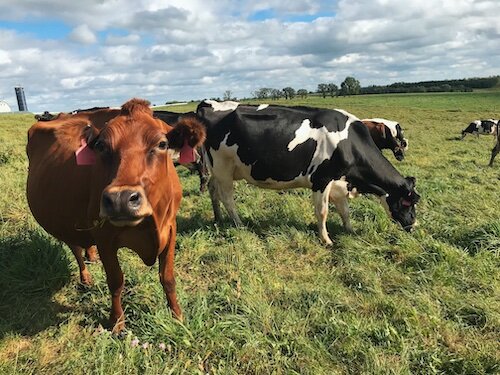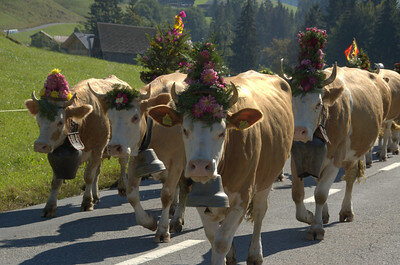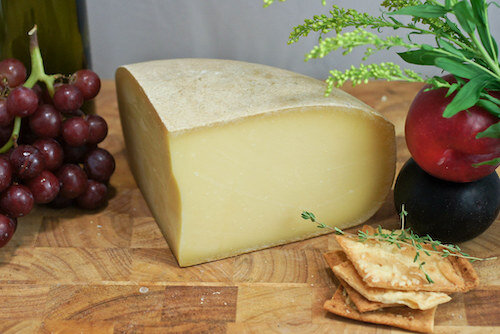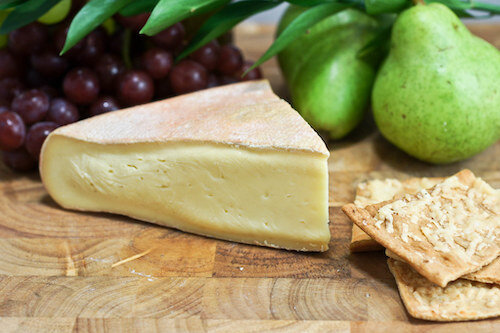For those of us who grew up eating bananas, strawberries, and yellow cheddar throughout the year, the concept of seasonality in food isn’t as intuitive as it would have been to our grandparents or great grandparents. “We’ve become a culture where people expect to see strawberries in the store year-round,” says Kat Feete, Cheesemaker at Meadow Creek Dairy in Galax, Virginia. The idea of only having access to food at certain times of the year is foreign in an industrialized food system.
But, even those who aren’t making what we think of as seasonal cheese must reckon with seasonality.
It’s All About the Milk
Cows at Uplands photo credit Christine Clark
Grass-fed dairy is in high demand these days. In fact, grass-fed dairy is “the most rapidly growing sector of the organic milk market,” University of Vermont agronomist Heather Darby told Country Folks in 2019. Cheesemongers love cheese made with grass-fed milk for its complexity and buttercup-yellow tinge. In most climates, grass is not a year-round reality.
There’s also the issue of milk supply. An animal’s lactation cycle can last anywhere from 90-300+ days, depending on the animal and the breed. Even if a producer has year-round access to the same kind of feed for their animals (usually some combination of hay, silage, and/or a grain ration), if they want their cheese to be available throughout the year, they need to stagger the breeding and lactation cycles of their animals. These cheeses may only be available for part of the year or depending on how long they’re aged, they may be available year-round.
Cows in L’Etivaz by James Stringer is licensed under CC BY-NC-ND 2.0
Vacherin Mont D’Or, for instance, is only available for a few months of the year, whereas L’Etivaz can be found year-round at different ages. Both are seasonal cheeses. The prime season for various pasture-based cheeses depends on the climate in which the cows live. Sweet Grass Dairy in Georgia, for instance, has access to fresh pasture for a higher percentage of the year than Uplands Cheese in Wisconsin does.
On top of that, there’s the issue of milk composition. Cheese is the preserved fat and protein from milk, meaning that milk with higher fat and protein content is better for cheesemaking. Throughout an animal’s lactation cycle, the fat and protein content can vary drastically. More industrial producers work around that by adding and subtracting fat and protein to milk. This could be as simple as adding in protein powder or much more complicated. Many seasonal cheesemakers choose to only offer one or two cheeses throughout the year, adjusting the recipe as they go to account for the difference in the milk.
Consistency Versus Complexity
“Pleasant Ridge Reserve Cheese” by artizone is licensed underCC BY-NC-ND 2.0
Andy Hatch, co-owner and cheesemaker at Uplands Cheese in Dodgeville, Wisconsin makes two cheeses: Pleasant Ridge Reserve in the summer and Rush Creek Reserve in the fall. He looks for a balance between consistency and complexity. “I’ve never thought that we wanted to celebrate variability for variability’s sake,” he says. “We’re after complexity and taste of place, and I think variability is just something that comes along with it, to some extent.” One of the ways that cheesemakers, whether seasonal or not, can improve their consistency is pasteurization, but Hatch finds that it also diminishes complexity.
“Rush Creek Reserve” by spersper is licensed under CC BY 2.0
Meadow Creek, who also makes cheese seasonally, also embraces seasonal change. In the spring, there’s a lot of milk, but it’s lower in fat and protein. Those cheeses taste a little grassier. Fall cheeses tend to be fudgier and richer. Because they make several different styles of cheese, they have cheese to sell year-round, but their flagship Grayson is only available about 9 months out of the year.
Are Seasonal Cheeses Better?
Seasonal cheeses, whether they be Grayson, Pleasant Ridge, or the Swiss L’Etivaz, have a mystique to them. Having something only be available for part of the year makes it more exciting when it’s around.
“Grayson Cheese” by artizone is licensed under CC BY-NC-ND 2.0
But, those aren’t the only benefits. Uplands and Meadow Creek has their cows all on the same calving cycle, meaning the cows all take a break from milking at the same time. “Farming can be pretty soul-draining when it’s 365 days a year,” says Feete “Having those 2-3 months off [from milking cows and making cheese] in the fall is great for us.” They find it easier to hire staff and to maintain the farm. “It’s a system that we’re committed to for a lot of reasons,” she continues. “This is the way that the grass works, so this is the way that we work. You can’t have it all.” Adds Hatch, “Seasonal food, whether it’s asparagus or strawberries or grass-fed cheese, draws us back to the realization that we depend on soil and weather to survive.”
